 Joe French is what I would consider your slightly above average player. He consistently shoots in the mid-80s. He hits the ball an average to above-average distance. He even has days where he can hit as many as nine fairways and 13 greens. However, he has reached the point where it is time to take the next step. It is time for Joe to start consistently shooting in the 70s. With a few changes, I think we can get him there.
Joe French is what I would consider your slightly above average player. He consistently shoots in the mid-80s. He hits the ball an average to above-average distance. He even has days where he can hit as many as nine fairways and 13 greens. However, he has reached the point where it is time to take the next step. It is time for Joe to start consistently shooting in the 70s. With a few changes, I think we can get him there.
You could probably freeze frame at any point in Joe’s swing and identify a problem. Even at full speed you could say that he takes the club back too far inside, creates no pivot, crosses at the top, casts during his down swing, comes inside, and then nearly jumps off the ground at impact. Ultimately, making a check list of faults is not going to help Joe. Our job is to identify which problem must be addressed next in order for him to achieve his goals.
Read on to see Joe’s swing and the fixes I’ve outlined for him.
The Swing
Joe’s swing can be seen here as a QuickTime movie. This shows the down-the-line and face-on angles with his driver and 6-iron. I would recommend that you to watch the video, identify what you think is his root problem, and then read on.
Lag
Lag has undoubtedly become one of the more popular topics in golf today. It is hard to watch a telecast – especially if Johnny Miller is a commentator – without seeing a super-slow motion video of Tiger Woods, Sergio Garcia, or any number of other players using lag. So, once and for all, let’s address what lag is and then address Joe’s swing with lag in mind.
What is Lag?
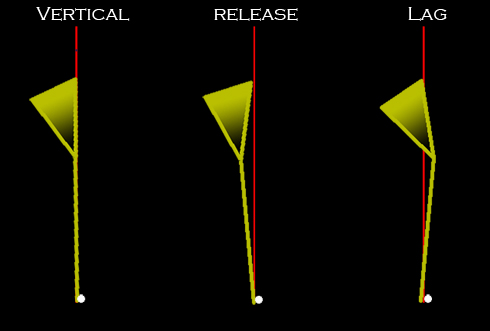
If you are looking at the illustration above, you can see that each of the three different types of swings have different relationships to a vertical line drawn through the backside of the golf ball.
- Vertical (0° of lag) – For a swing that has a vertical impact, which is common among both tour pros and good amateurs, the shaft of the club overlaps with the vertical line drawn through the backside of the golf ball. This means at impact, the loft of the club has no change.
- Release (negative lag) – For a swing with a release, which is common among mid- to high-handicappers, the shaft of the club is angled away from the target at impact. This means that the player is adding loft to the club at impact.
- Lag – For a swing that has lag, the shaft of the club is angled towards the target at impact. This means that the player is delofting the club at impact.
You might be asking yourself why lag is important. There’s a pretty complicated physics-based answer to that question, but the two simplest reasons are: 1) lag maximizes acceleration and 2) lag helps create an optimal launch angle for every club in your bag.
Joe’s Lag
One of the major problems with Joe’s swing is that rather than creating lag, Joe is casting. Take a look at the two frames below.
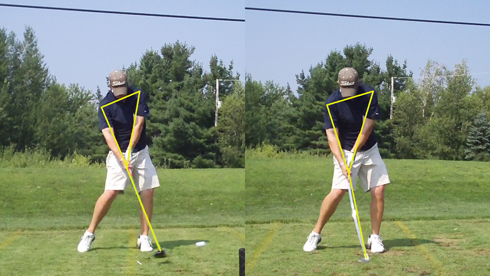
As you can see above, Joe’s impact position resembles that of a release rather than lag. Had Joe swung correctly, Joe should have had 2-4° of lag with his driver and 7-9° of lag with his 6-iron. Instead, Joe has -21° of lag with his driver and -15° of lag with his 6-iron. This means that at impact, if Joe was hitting a 10° driver, his driver now has a loft of 31°.
Helping a player create more lag can be incredibly tricky. If a player has mastered all other components of his swing, then he should naturally create lag. However, some teachers view lag as such a swing key that they feel that if their students can master that concept that all other parts of the swing will naturally become better. Confused? So are many golfers, so don’t feel bad.
Just to be clear on where I stand on that argument, it is my opinion that once you master a few key components of the swing that you can attempt to attack lag directly. In Joe’s case, I believe we have to address his leading shoulder first.
Leading Shoulder at Impact
One of the most fundamental parts of any golf swing – be it with the sand wedge or the driver – is the position of your leading shoulder at impact. With your driver, the ball should be positioned off of your leading heel at set-up with your leading hip and leading shoulder positioned off of the same line. To have the best chance of hitting a ball dead straight with lag, your leading shoulder must be either at or slightly behind the ball at impact.
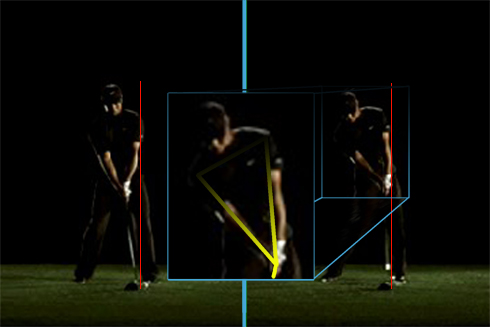
The position of your leading shoulder at impact with your irons and wedges is slightly more complicated. Regardless of ball position, your shoulder and leading hip should start off on the same line at set up. Again, to have the best chance of hitting the ball dead straight with lag, your leading shoulder should be either at or slightly behind that line at impact.
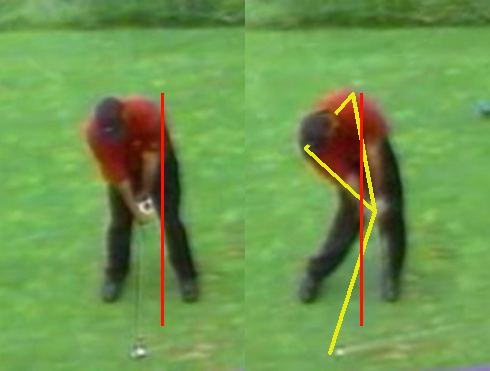
Joe’s Leading Shoulder
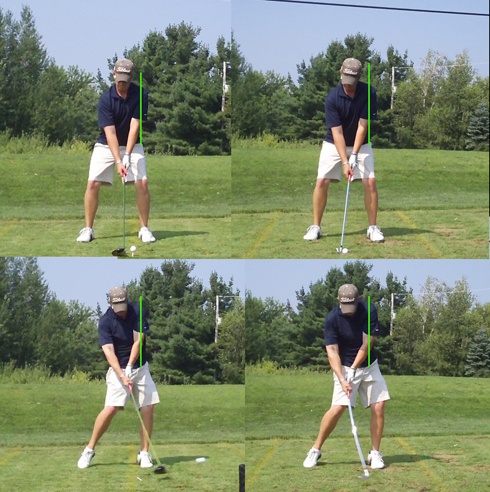
Looking at Joe’s set up and impact position we can easily see some problems. First, although Joe’s set up looks relatively athletic, he is starting with his left shoulder in front of his left hip. Second, Joe’s best efforts to get his shoulder behind the ball at impact – which includes his left foot almost coming completely off the ground – were not successful. With these two faults combined, Joe is going to make it nearly impossible to: 1) come down on-plane, 2) create lag, and most importantly 3) hit a straight shot.
Potential Fixes
To help Joe achieve the proper impact position he needs to make two significant changes.
Set Up
If I really wanted to start a firestorm, I would advocate for Joe to position the ball for every club in the bag off of the instep of his left foot. I will leave that battle for another day and simply state that at set up – regardless of ball position – your leading shoulder should be in line with the front of your leading hip. While you could start with your shoulder in front of your hip, positioning your shoulder and hip on the same line primes your swing for the proper impact position as well as create more torque during your back swing. Take a look below at my harshly edited version of how I would want Joe to set up with his driver.
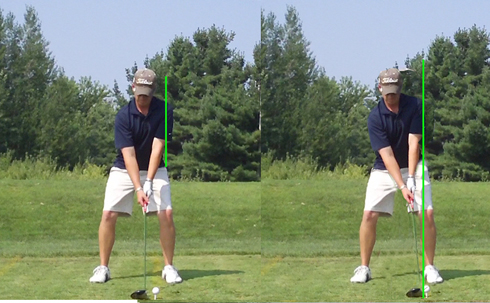
There are two different thoughts that I have found successful to achieve this position. You can focus on:
Leading Shoulder & Hip – Try to feel as if you are pushing your leading hip slightly towards the target while tilting your shoulder away from the target.
Head & Hip – Try to feel as if you are pushing your leading hip slightly towards the target as you feel like your left ear is behind the zipper of your pants/shorts.
Regardless of which feel you choose, be sure to check to see how close you are either in a mirror or on camera.
Leading Shoulder
Here is my personal favorite drill to address this problem.
- When you tee up the golf ball, place the label so that it is under the horizon line just barely visible to you when you are set up.
- During your backswing, do not take your eye off of the label.
- During your down swing, do not take your eye off of the label. If you can’t see the label, then you shifted your head forward. If you shifted your head forward odds are you shifted your leading shoulder forward as well.
- Check your swing on camera. Do not just rely on the feel alone.
Time Line: If you work on this consistently then this change can be made in two to three weeks time. Be warned though, if you do not focus on this for every single club in your bag then this change can take in infinite amount of time.
Be sure to monitor… Your hips. For many golfers, they feel as if they are swinging up at the ball when they first attempt to make this change. It is incredibly important to remember that you do not sway behind the ball during your back swing and your lower body should continue to move through the ball during your down swing and follow through.
Conclusion
While consistently shooting in the 80s is a huge accomplishment, consistently shooting in the 70s just feels so much bigger. Truth is, it is. Shooting in the 70s takes so much more precision; so many fewer mistakes can be made. Most of all, it takes having a swing which you can truly rely on. Hopefully by making this change, Joe will be that much closer to achieving his goal.
Your Turn!
If you’re interested in having your swing analyzed in a future edition of Swing Check here on The Sand Trap, check out the requirements page and submit your videos today!

I’m confused. Is the photo of the guy in red (Woods?) the correct way or the wrong way? It looks like the wrong way to me, because his left shoulder is way in front of the ball at impact.
“The position of your leading shoulder at impact with your irons and wedges is slightly more complicated. Regardless of ball position, your shoulder and leading hip should start off on the same line at set up. Again, to have the best chance of hitting the ball dead straight with lag, your leading shoulder should be either at or slightly behind that line at impact.”
Having your shoulder behind the ball at impact with a progressive ball position OR the ball placed back in your stance would be nearly impossible. The idea is for your shoulder (the center of your swing) to return to the point where it started at set up.
Thanks. So the guy in red in the picture is the wrong way, because his left shoulder is not in the same posistion as at address.
No. His left shoulder is in the same position RELATIVE to the red line. That position is correct.
I agree that learning how to hit with a lag will lower your handicap. But I would suggest that the average golfer reading this article won’t be able to translate the instructions to the driving range.
I learned the lag by practising my chipping and pitching. With the slower and shorter swing involved, I could get the feel for my left (forward) hand being ahead of the ball at impact. And keeping the back of left wrist flat (so I would not scoop or flip at the ball).
Besides improving my chipping and pitching, I was then able to progress up to a full swing with the same feel.
I really enjoy this swing analysis series. But, speaking from experience, if you want to go from a 16 to a 10, learn how to chip, pitch and putt.
That’s the problem with experience: it’s unique.
Joe’s chipping and putting is pretty good. Mine was pretty good as a 3.0 index – overhauling my full swing has dropped my handicap index a shot and a half.
Some people lower their handicap with a good short game and putting – others lean on it too much and can really be helped by improving their full swing.
Joe is one of the latter types, and fixing his full swing will help him much more than extra chipping and putting time.
Still confused. “That position is correct.” Then what would you call Wood`s position in the photos above “the guy in red”? More correct? Tiger`s impact position seems to meet the defenition of “relative”. Relative to the red line, his left shoulder is in the same position. The guy in red, his shoulder has moved forward. Meaning, if Wood`s shoulder is correct, how could the guy in reds be?
I’ve been practicing lag for a while now. I realise one of my problems is no divot and a high launch angle so I’m thinking I’m adding loft or casting – like Joe. Though the majority of my shots are straight – I do want to have a more penetrating flight. Anyway, one shot that I’ve found to be helpful in getting the sensation of lag is the knock down where I hold the angle between wrist and club as long as I can before contact – though I’m not even sure I’m doing that right. 😉
As a golf instructor for over 5 years, I have seen many Joe-type swings on the practice range and one of the most common reasons for golfers casting, and therefore creating negative lag, is reverse pivoting.
I’m certain the most damaging piece of advice given to beginners is “keep your head still”. By keeping their head still over the ball there is no weight transfer to the non-target foot (weight stays on target foot) and the result is the player having to fall back on to their non-target foot, flipping their hands at the ball in order to make contact. The key word here is HAVING as they can’t do anything about it, it’s an automatic reaction to no or little weight transfer during the backswing.
I’ve found that once the student understands this concept they quite quickly start hitting the ball better. The ball is struck with more power and the flight of the ball is lower and more penetrating. This, of course, equates to more distance which delights the student no end!
If the student is NOT reverse pivoting then they are staying back on their non-target foot at impact because they are trying to hit the ball rather than swing through it. When they do this they try to help the ball up into the air and that’s where the casting comes from. I then work with the student to stay down through the shot, as if hitting a punch shot, and finish their weight transfer on to their target foot.
Without having to talk lag, most students are able to improve their impact positions with the drills above.
Does lag relate to delayed release on the downswing?
I was working on swing drills at the range yesterday, and found I wasn’t “dropping the hands” consistently. I have had trouble with some wild swings lately while playing, and with lots of distance differences from the same short iron.
So, does smoothly “dropping the hands” at start of downswing help contribute to good lag?
I am currently working on this concept of lag. SOme info- I have been playing since Junior year of high school (so I guess around 5 years). I typically hit my driver 260-315, 7 iron 175, and I usually shoot around 80 or so. My swing can be very good, but I am often very inconsistent due to less playing time with school. I agree with the full swing needs work thing. If you are a pretty good short gamer, then work on your full swing.
One of the things that I have been working on is maintaining my wrist hinge to impact. I heard that this increases your attack angle and lag, is this true? I have been trying this, and I didn’t play very well. WHen I hit some good shots, I hit some REALLY good shots. Maybe it’s just getting used to holding the hinge. WHat do you guys think- hinge for more lag, power, and accuracy?
Yes. Players who try to accelerate out of the top of their swing are increasing centripetal force which pulls the club outward. See Sergio Garcia 🙂
The basic answer is yes but it is slightly oversimplified. See Ben Hogan.
I do not believe this guy’s swing can score in the 80’s. If I saw that set up on the first tee I would bet the the house. This is the the swing of the “reverse sandbagger” a guy who probably doesn’t putt the short ones, stops counting his score at double bogey, does not take stroke and distance for a lost ball etc. etc. Plus does he play a golf course with hazards? I would have guessed that swing couldn’t shoot 90. I like all the tips to help him